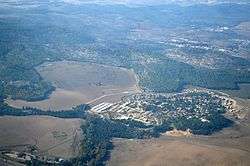Giv'at Oz
| Giv'at Oz גִּבְעַת עֹז, גבעת עוז | |
|---|---|
|
Arial photo of Giv'at Oz and it's serrounding area | |
 Giv'at Oz | |
| Coordinates: 32°33′19.52″N 35°12′1.09″E / 32.5554222°N 35.2003028°ECoordinates: 32°33′19.52″N 35°12′1.09″E / 32.5554222°N 35.2003028°E | |
| District | Northern |
| Council | Megiddo |
| Affiliation | Kibbutz Movement |
| Founded | 20 September 1949 |
| Founded by | Hungarian Jews |
| Population (2015)[1] | 469 |
Giv'at Oz (Hebrew: גִּבְעַת עֹז, lit. Hill of Strength) is a kibbutz in northern Israel. Located in the Jezreel Valley between Umm al-Fahm and Afula, it falls under the jurisdiction of Megiddo Regional Council. In 2015 it had a population of 469. The kibbutz lies north to Zalafa and Salem and Highway 66 runs near it.[2]
Etymology
Giv'at Oz was named after the battles that occurred in the region during the 1948 Arab–Israeli War.[3]
History
The territory on which Giv'at Oz was built was transferred from Transjordan to Israel as part of the Israeli–Jordanian Armistice Agreement of 1949.[2]
In 1948, Holocaust survivors from Hungary, members of Hashomer Hatzair established a gar'in named "Yas'ur". The members received training in Hungary and in some kibbutzim in Israel. On 20 September 1949 the gar'in members established the kibbutz near the Arab village of Zalafa.[4] In the early years the kibbutz suffered from lack of water, which was brought in tankers from Afula. In 1953 the water company Mekorot connected the kibbutz to a water system, allowing the agriculture sector to develop. In later years, Jewish immigrants from Brazil and members of various youth movements joined the kibbutz.[5] In the kibbutz's first year, Jordanian forces stole a flock of five hundred sheep from the kibbutz after a brief fight. Most of the sheep were brought back thanks the UN intervention.[2] Until 1967 Giv'at Oz had the legal status of a border settlement, which gave it the right to have war reparations as it was built near the West Bank which was then controlled by Jordan.[3]
In the late 1950s, Giv'at Oz established good relations with the nearby Arab villages Zalafa and Salem when a Kupat Holim clinic was built in the kibbutz and also served the nearby villages. Later the kibbutz provided water and transportation services to the villages and social contact was built up between both communities as the Arab villagers started learning Hebrew.[2]
Towards the Six-Day War in 1967, trucks and tractors as well as many of the residents were conscripted to the army in May of that year. Youth from cities volunteered to help the kibbutzim that lied near the border in bringing the harvest and villagers from Zalafa and Salem also helped the kibbutz when many of its men were conscripted.[6] In the first hours of the war, the Jordanian army shelled the kibbutz which suffered from minor damage, as well as other kibbutzim near the Jordanian border. Israeli forces later passed through the kibbutz and enetered the Jordanian-controlled West Bank to capture Jenin.[7] Three Jordanian hunter jets attacked an Israeli convoy in the kibbutz; the workshop was damaged and an Israeli lieutenant was injured.[8]
The kibbutz remains cooperative in nature and offers welfare services to the residents.[3]
Economy
In the early 1980s, the "Aromor" fragrance factory was established in order to reduce the kibbutz's dependency on agriculture. By 2011 the factory provided 40% of the local budget.[9] In 2014 it was sold to the American Company International Flavors & Fragrances.[10]
References
- ↑ "List of localities, in Alphabetical order" (PDF). Israel Central Bureau of Statistics. Retrieved 16 October 2016.
- 1 2 3 4 Bernet, Michael (August 2004). page 44–45.
- 1 2 3 "גבעת עז (Giv'at Oz)" (in Hebrew). Galilee Development Authority. Retrieved 19 May 2016.
- ↑ Morris, Benny (2004). The Birth of the Palestinian Refugee Problem Revisited. Cambridge University Press. p. xxii. ISBN 0-521-00967-7.
- ↑ "גבעת עוז - קיבוץ [Giv'at Oz - Kibbutz]" (in Hebrew). Israeli Labour Movement. Retrieved 19 May 2016.
- ↑ Bernet, Michael (August 2004). page 46.
- ↑ Bernet, Michael (August 2004). pages 83-84.
- ↑ Bernet, Michael (August 2004). page 129.
- ↑ Gabizon, Yoram (22 March 2011). ""קשה לי לראות את גבעת עוז מתקיים בכבוד בלי ארומור" [It is hard to see Giv'at Oz exist in dignity without Aromor]". Haaretz. p. Hebrew. Retrieved 19 May 2016.
- ↑ Shavit, Ilan (15 January 2014). "IFF To Acquire Aromor Flavors Of Kibbutz Givat Oz In Israel For $88 Million". Jewish Business News. Retrieved 20 May 2016.
Bibliography
- Bernet, Michael (August 2004). The Time of the Burning Sun: Six Days of War, Twelve Weeks of Hope. Chester and West. p. 44. ISBN 0975582518.
